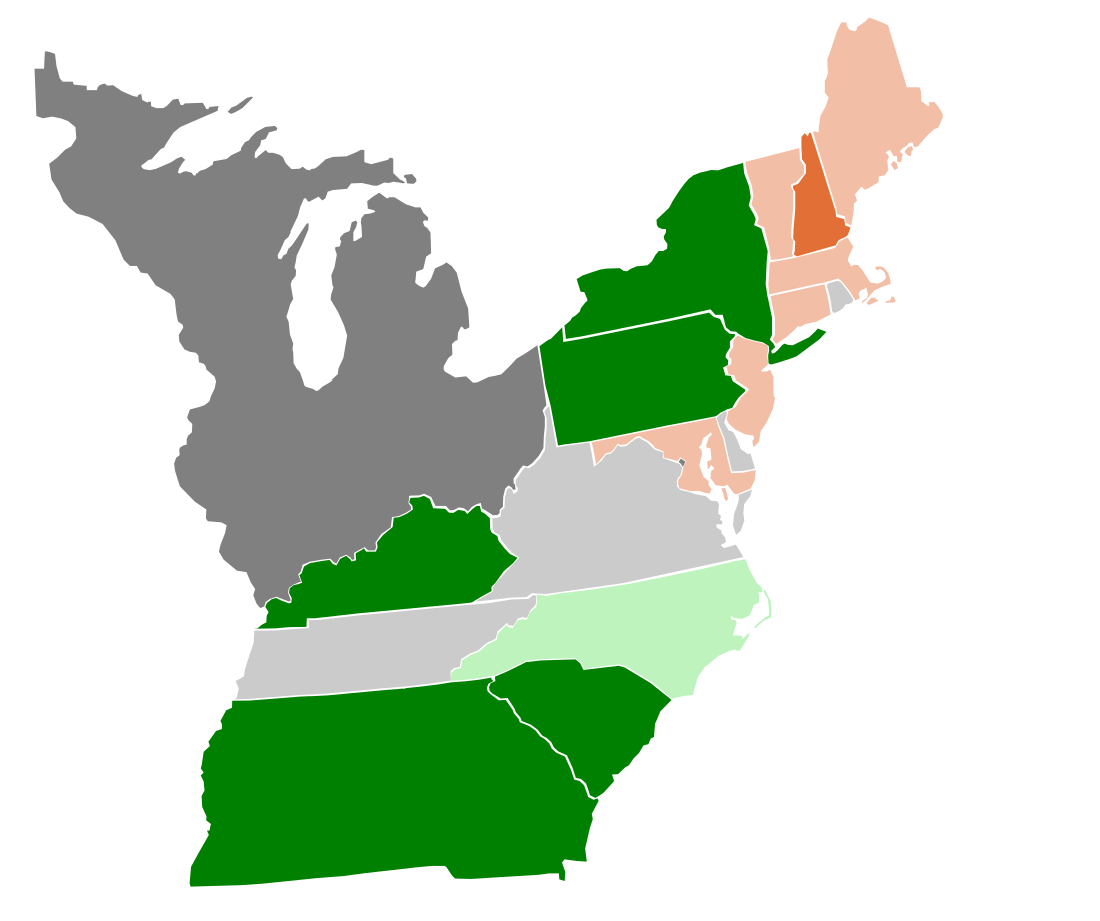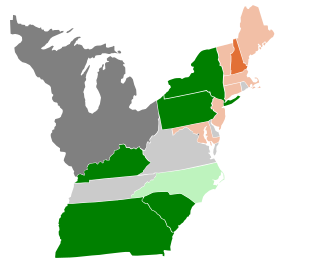Top Qs
Timeline
Chat
Perspective
1800–01 United States Senate elections
From Wikipedia, the free encyclopedia
Remove ads
The 1800–01 United States Senate elections were held on various dates in various states, coinciding with Thomas Jefferson being elected to the White House. As these U.S. Senate elections were prior to the ratification of the Seventeenth Amendment in 1913, senators were chosen by state legislatures. Senators were elected over a wide range of time throughout 1800 and 1801, and a seat may have been filled months late or remained vacant due to legislative deadlock.[1] In these elections, terms were up for the senators in Class 3.
Remove ads
Although the Federalists began the 7th Congress with a slim majority, Jefferson's Democratic-Republican Party took over the majority shortly thereafter due to mid-year special elections. By the time the first proper session of the 7th Congress met in December 1801, three seats had been gained by the Democratic-Republicans, leaving them with an overall majority of 17 seats and a government trifecta.
Remove ads
Change in composition
Summarize
Perspective
Before the November elections
After the November 6, 1800 special election in New York.
| DR6 | DR5 | DR4 | DR3 | DR2 | DR1 | ||||
| DR7 | DR8 | DR9 N.H. Ran |
DR10 N.Y. Ran |
DR11 N.C. Retired |
F21 Vt. Ran |
F20 S.C. Ran |
F19 Pa. Retired |
F18 Md. Unknown |
F17 Ky. Ran |
| Majority → | |||||||||
| F7 | F8 | F9 | F10 | F11 | F12 | F13 | F14 | F15 Conn. Ran |
F16 Ga. Retired |
| F6 | F5 | F4 | F3 | F2 | F1 | ||||
Result of the November elections
| DR6 | DR5 | DR4 | DR3 | DR2 | DR1 | ||||
| DR7 | DR8 | DR9 Ga. Gain |
DR10 Ky. Gain |
DR11 N.Y. Re-elected |
DR12 N.C. Hold |
DR13 Pa. Gain |
DR14 S.C. Gain |
V1 Md. F loss |
F17 Vt. Re-elected |
| Majority → | |||||||||
| F7 | F8 | F9 | F10 | F11 | F12 | F13 | F14 | F15 Conn. Re-elected |
F16 N.H. Gain |
| F6 | F5 | F4 | F3 | F2 | F1 | ||||
Beginning of the 7th Congress, March 4, 1801
| DR6 | DR5 | DR4 | DR3 | DR2 | DR1 | ||||
| DR7 | DR8 | DR9 | DR10 | DR11 | DR12 | DR13 | DR14 | F18 Md. Appointed |
F17 |
| Majority → | |||||||||
| F7 | F8 | F9 | F10 | F11 | F12 | F13 | F14 | F15 | F16 |
| F6 | F5 | F4 | F3 | F2 | F1 | ||||
End of 1801
| DR6 | DR5 | DR4 | DR3 | DR2 | DR1 | ||||
| DR7 | DR8 | DR9 | DR10 | DR11 | DR12 | DR13 Md. Gain |
DR14 Pa. Hold |
DR15 R.I. Gain |
DR16 S.C. Hold |
| Majority → | DR17 Vt. Gain | ||||||||
| F7 | F8 | F9 | F10 | F11 | F12 | F13 | F14 | F15 N.H. Hold | |
| F6 | F5 | F4 | F3 | F2 | F1 | ||||
Remove ads
Race summaries
Summarize
Perspective
Except if/when noted, the number following candidates is the whole number vote(s), not a percentage.
Special elections during the preceding Congress
In these special elections, the winner was seated before March 4, 1801; ordered by election date.
Races leading to the next Congress
In these regular elections, the winner was seated on March 4, 1801; ordered by state.
All of the elections involved the Class 3 seats.
Special elections during the next Congress
In these special elections, the winner was seated after March 4, 1801; ordered by election date.
Remove ads
Connecticut

Federalist Uriah Tracy was easily re-elected.
This section needs expansion. You can help by adding to it. (September 2020) |
Georgia
This section needs expansion. You can help by adding to it. (September 2020) |
Kentucky
This section needs expansion. You can help by adding to it. (September 2020) |
Maryland
Summarize
Perspective
Maryland (special, 1800)
This section needs expansion. You can help by adding to it. (November 2022) |
William Hindman won election over Richard Tilghman Earle by a margin of 10.11%, or 9 votes, for the Class 3 seat.[20]
Maryland (regular)
The Maryland legislature failed to elect a senator before the March 4, 1801 beginning of the term. As such, William Hindman was appointed to fill the vacancy, and retired when a successor was elected.
Maryland (special, 1801)
This section needs expansion. You can help by adding to it. (November 2022) |
Robert Wright won election over William Winder by a margin of 39.53%, or 34 votes, for the Class 3 seat.[21]
Remove ads
Massachusetts
Massachusetts (special, class 2)
This section needs expansion. You can help by adding to it. (September 2020) |
Massachusetts (special, class 1)
This section needs expansion. You can help by adding to it. (September 2020) |
New Hampshire
New Hampshire (regular)
This section needs expansion. You can help by adding to it. (September 2020) |
New Hampshire (special)
This section needs expansion. You can help by adding to it. (September 2020) |
New Jersey (special)
This section needs expansion. You can help by adding to it. (September 2020) |
New York
New York (regular)
New York (special, class 1)
New York (special, class 3)
Remove ads
North Carolina
This section needs expansion. You can help by adding to it. (September 2020) |
Pennsylvania
Pennsylvania (regular)
Pennsylvania (special)
Rhode Island (special)
This section needs expansion. You can help by adding to it. (September 2020) |
South Carolina
South Carolina (regular)
This section needs expansion. You can help by adding to it. (September 2020) |
South Carolina (special)
This section needs expansion. You can help by adding to it. (September 2020) |
Vermont
Vermont (regular)
This section needs expansion. You can help by adding to it. (September 2020) |
Vermont (special)
This section needs expansion. You can help by adding to it. (September 2020) |
See also
References
Wikiwand - on
Seamless Wikipedia browsing. On steroids.
Remove ads


